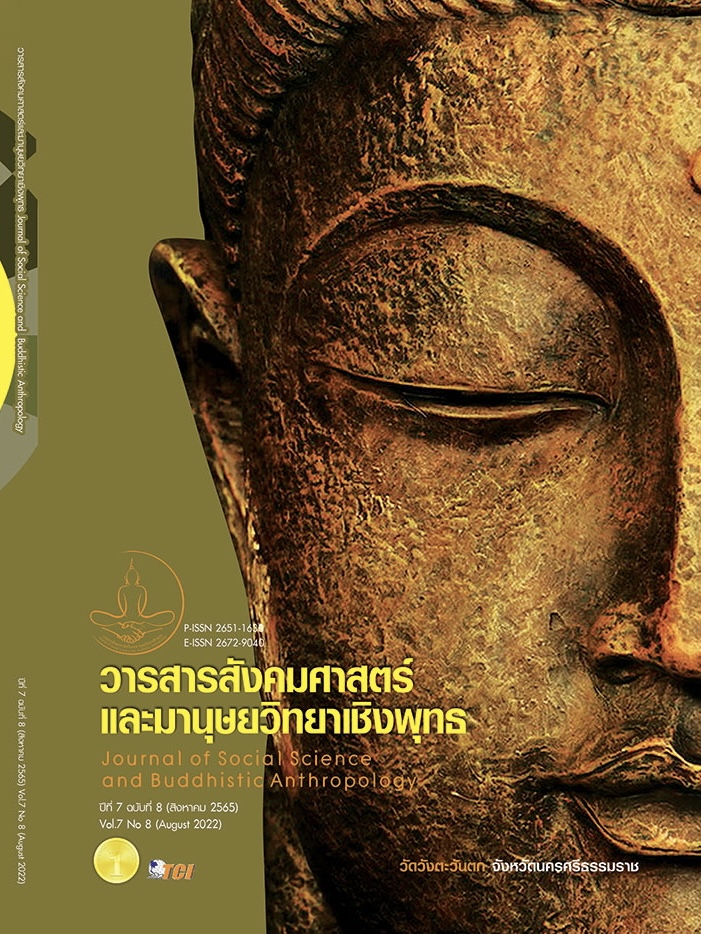THE POTENTIAL DEVELOPMENT TO THE YOUTH FOR READY TO CARE ELDERS BASED ON BUDDHISM
Keywords:
: Development, Potential to The Youth, Care Elders, Based on BuddhismAbstract
The objectives of this research article were to: 1) study concepts and theories of the potential development to the youth for ready to care the elderly based on Buddhism, 2) study the Dhamma about the potential development to the youth for ready to care the elderly based on Buddhism, 3) integrate the Dhamma of the potential development to the youth for ready to care the elderly based on Buddhism, and 4) to propose a guideline and a knowledge model in the potential development to the youth for ready to care the elderly based on Buddhism. Research methodology is a qualitative research by means of document studies, in-depth interview of 15 key informants, and focus group of 11 persons. The results of the study indicated that: 1) Concepts and theories of the potential development to the youth are the condition to the driving force that drives and pushes the youth to have competent behaviors which are attitude, knowledge and skills. 2) The Dhamma of Buddhism can be integrated in the potential development to the youth for ready to care the elderly that consists of gratitude and ten kinds of the Puññakiriyãvatthu. 3) Integration of Dhamma principles is finding ways to the potential development to the youth for ready to care the elderly. It consists of the guidelines: 3.1) the attitude aspect, arising from internal and external stimulation, 3.2) knowledge aspect, arising from knowledge creation and knowledge transfer, and 3.3) Skill aspect, arising from physical and behavior. 4) Knowledge of the potential development to the youth for ready to care the elderly based on Buddhism is a method that is established and sustained based on dharma principles consisting of Kataññu katavedi and ten kinds of the Puññakiriyãvatthu in the form of “YAKSE MODEL”
References
กรมพัฒนาสังคมและสวัสดิการ. (2565). ผู้สูงอายุ. เรียกใช้เมื่อ 9 เมษายน 2565 จาก http://164.115.22.122/dsdw/index.php
ธีรโชติ เกิดแก้ว. (2547). บุญคือปัจจัยพื้นฐาน : บทวิเคราะห์จากปัญหาในสังคมไทย. วารสาร มฉก. วิชาการ, 7(14), 70-84.
ประทีป ทัตอัตตานนท์. (2562). สิทธิของผู้สูงอายุในประเทศไทย. กรุงเทพมหานคร: ปณรัชช.
พระครูกันตธรรมาภิวัฒน์ (น้อย กนตสีโล). (2563). การสร้างความสัมพันธ์ผู้สูงอายุกับเยาวชนตามหลักธรรมทางพระพุทธศาสนา. ใน วิทยานิพนธ์พุทธศาสตรมหาบัณฑิต สาขาวิชาพระพุทธศาสนา. มหาวิทยาลัยมหาจุฬาลงกรณราชวิทยาลัย.
พระครูศรีสุตโสภณ (เงิน ชาตเมธี). (2549). ความกตัญญูกตเวทีในฐานะคุณธรรมค้ำจุนสังคมจากมุมมองพระพุทธศาสนา. ใน วิทยานิพนธ์พุทธศาสตรมหาบัณฑิต สาขาวิชาพระพุทธศาสนา. มหาวิทยาลัยมหาจุฬาลงกรณราชวิทยาลัย.
พระธรรมปิฎก (ป.อ. ปยุตฺโต). (2553). พจนานุกรมพุทธศาสน์ ฉบับประมวลศัพท์ (พิมพ์ครั้งที่ 15). กรุงเทพมหานคร: บ. สหธรรมิก.
พระแวงชัย ธมฺมกาโม (หล้าลี). (2561). การพัฒนาคุณภาพชีวิตด้วยบุญกิริยาวัตถุ. ใน ดุษฎีนิพนธ์ศาสนศาสตรดุษฎีบัณฑิต สาขาวิชาพุทธศาสน์ศึกษา. มหาวิทยาลัยมหามกุฏราชวิทยาลัย.
มหาจุฬาลงกรณราชวิทยาลัย. (2539). พระไตรปิฎกฉบับภาษาไทย ฉบับมหาจุฬาลงกรณราชวิทยาลัย. กรุงเทพมหานคร: โรงพิมพ์ มหาจุฬาลงกรณราชวิทยาลัย.
มหามกุฏราชวิทยาลัย, มูลนิธิ. (2552). พระไตรปิฎกและอรรถกถาแปลฉบับมหามกุฏราชวิทยาลัย (91 เล่ม). กรุงเทพมหานคร: โรงพิมพ์มหามกุฏราชวิทยาลัย.
วนัญญา แก้วแก้วปาน. (2560). สัมพันธภาพครอบครัวกับปัญหาการกระทำความผิดในวัยรุ่น. วารสาร Veridian E-journal Silpakorn University, Vol. 10(1), 361-371.
ศุภวุฒิ สายเชื้อ. (2564). น่าเป็นห่วง “สังคมสูงวัย” แนวโน้มประชากรของไทย. เรียกใช้เมื่อ 7 เมษายน 2565 จาก https://www.prachachat.net/columns/news-786842
สมสุข นิธิอุทัย. (2554). การพัฒนาเยาวชนตามแนวพุทธในสังคมไทย. ใน วิทยานิพนธ์พุทธศาสตรมหาบัณฑิต สาขาวิชาพระพุทธศาสนา. มหาวิทยาลัยมหาจุฬาลงกรณราชวิทยาลัย.
สำนักบริหารการทะเบียน. (2565). จำนวนประชากรไทย แบ่งตามช่วงอายุ รายจังหวัด ณ เดือน กุมภาพันธ์ 2565. เรียกใช้เมื่อ 9 เมษายน 2565 จาก https://www. bora.dopa.go.th/index.php/th/
สุภาภรณ์ สุดหนองบัว. (2564). การดูแลผู้สูงอายุ : สถานการณ์และคุณภาพชีวิต. กรุงเทพมหานคร : สำนักพิมพ์จุฬาลงกรณ์มหาวิทยาลัย.
Downloads
Published
How to Cite
Issue
Section
License
Copyright (c) 2022 Journal of Social Science and Buddhistic Anthropology

This work is licensed under a Creative Commons Attribution-NonCommercial-NoDerivatives 4.0 International License.








